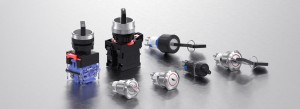What is the difference between a push button and a selector switch?

Push buttons and selector switches are two common components used in control systems and electrical circuits. While both serve as user interfaces for controlling various devices and processes, they have distinct characteristics and applications. In this article, we will explore the key differences between push buttons and selector switches to help people understand when and how to use each of them effectively.
1. Basic Functionality:
Push Button: Push buttons are momentary switches that are typically used for simple, on/off operations. When people press a push button, it momentarily closes or completes an electrical circuit, allowing current to flow and activate a specific function or device. As soon as they release the button, it returns to its original position, breaking the circuit.
Selector Switch: Selector switches, on the other hand, provide multiple options or positions that they can select by turning the switch. Each position corresponds to a specific function or setting. Selector switches maintain their chosen position until manually changed, making them suitable for applications requiring multiple settings or modes.
2. Types and Variations:
Push Button: Push buttons come in various forms, including momentary and latching types. Momentary push buttons return to their default position when released, while latching push buttons stay in their pressed position until they press them again to release. They can be simple, illuminated, or have a protective cover.
Selector Switch: Selector switches offer a wide range of options, including rotary switches and key switches. Rotary selector switches have a knob or lever that rotates to select different positions, while key selector switches require a key to change settings, making them useful for security purposes. They are available in 2-position, 3-position, or even 4-position configurations.
3. Applications:
Push Button: Push buttons are commonly used for straightforward tasks such as turning lights on and off, starting and stopping machinery, or initiating an emergency shutdown. They are ideal for applications where a momentary action is sufficient.
Selector Switch: Selector switches are more suitable for applications that require users to choose between various operating modes, settings, or functions. For instance, they can be found on machinery with multiple operation modes, like different speed settings on a conveyor belt or various washing cycles on a washing machine.
4. Feedback and Visibility:
Push Button: Push buttons often provide tactile feedback, such as a click or resistance when pressed, allowing users to confirm that they have activated the desired function. Illuminated push buttons may have indicator lights that show the current status.
Selector Switch: Selector switches provide clear visual feedback by indicating the selected position directly on the switch. This can help users easily identify the chosen mode or setting, making them more user-friendly in complex control systems.
In conclusion, push buttons and selector switches serve distinct purposes in control and electrical systems. Push buttons are best suited for simple on/off actions, while selector switches excel when multiple settings or modes are required. Choosing the right component for their application is crucial for efficient and safe operation. Understanding the differences between these two devices will help them make informed decisions when designing or maintaining control systems.
Media Contact
Company Name: ONPOW Push Button Manufacture Co., Ltd.
Email: Send Email
Phone: +86-577-62628788
Country: China
Website: https://www.onpowbutton.com/

